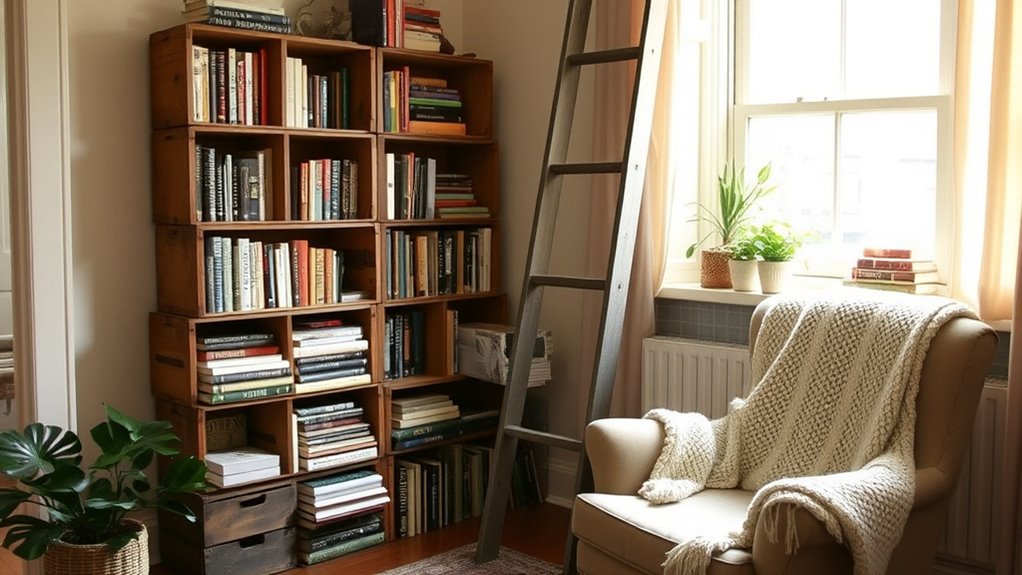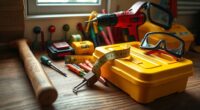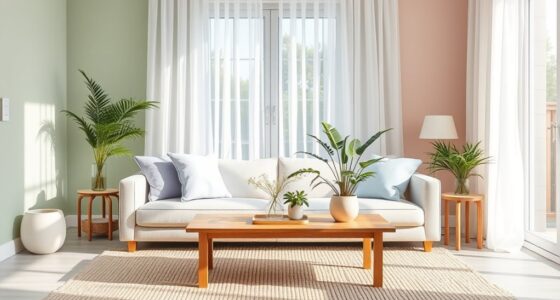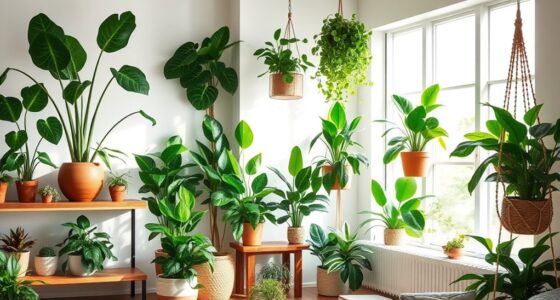To set up a home library on a budget, start by evaluating your space and choosing smart storage options like repurposed crates, pallets, or floating shelves. Curate your collection carefully, focusing on books that inspire or challenge you. Shop at thrift stores, online marketplaces, and library sales for affordable titles, and consider DIY projects to create unique shelves. Organize and decorate thoughtfully, and explore community swaps to expand your collection cost-effectively. Continue exploring tips to make your space truly yours.
Key Takeaways
- Measure your space and choose affordable, space-efficient furniture like repurposed crates or DIY shelves.
- Curate your collection by selecting meaningful books and organizing them with budget-friendly tools.
- Create DIY or upcycled bookshelves using pallets, vintage suitcases, or wall-mounted brackets.
- Purchase used books from thrift stores, library sales, and online marketplaces to expand your collection affordably.
- Incorporate community book swaps and resourcefulness to keep your library diverse and sustainable on a budget.
Assess Your Space and Storage Options
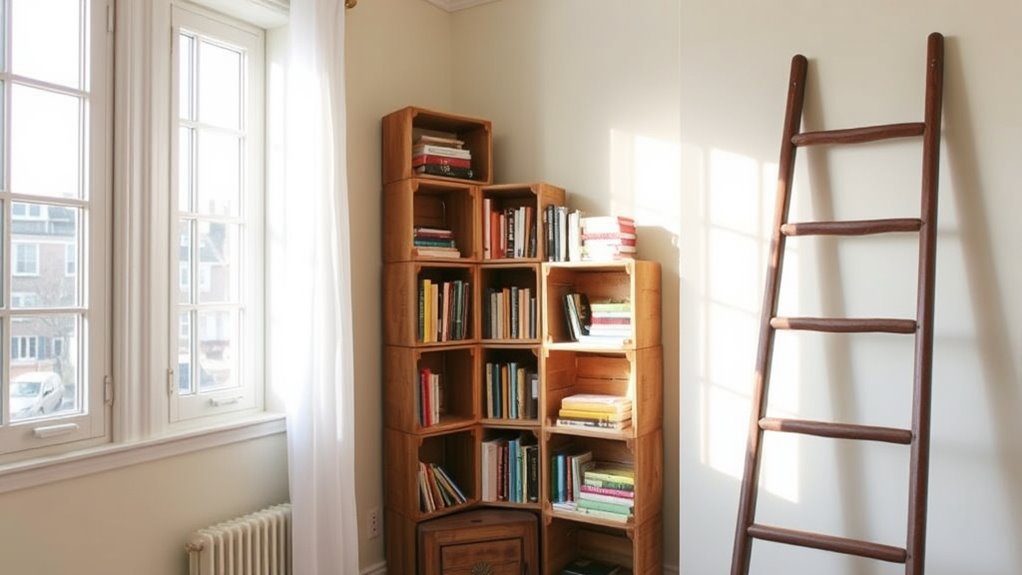
Before you start gathering books, it’s essential to evaluate your available space and storage options. Measure your room, noting areas where shelves or cabinets can fit without cluttering walkways. Consider how room lighting affects the ambiance; natural light is ideal, but if that’s limited, plan for affordable solutions like desk lamps or string lights. Think about seating arrangements that maximize comfort and functionality without overcrowding the space. A cozy reading nook or a small sofa can make your library inviting. By assessing these elements early, you’ll avoid overbuying or mismatched furniture. Additionally, understanding storage options for your books can help you make smarter choices and optimize your space. Effective use of space and thoughtful lighting and seating will create an inviting atmosphere that encourages reading without stretching your budget.
Curate Your Collection With Purpose

Once you’ve assessed your space and storage options, it’s time to focus on building a collection that truly reflects your interests and reading habits. Curate with purpose by selecting books that inspire, challenge, or bring you joy. Avoid clutter by choosing titles that fit your reading goals, and consider integrating book-themed decor to enhance your space. When designing your reading nook, showcase your favorite books prominently, creating a cozy atmosphere that invites you to unwind. Be intentional about the variety and quantity of books you keep—stay selective to prevent overwhelm and maintain an organized look. Remember, your collection should be a reflection of you, making your home library a personal sanctuary that encourages regular reading and discovery. Additionally, understanding resources and tools available for organizing and maintaining your collection can help you develop an efficient system that keeps your library accessible and enjoyable.
Find Affordable and Creative Bookshelves

Looking for affordable and creative ways to display your books? You can explore decorative shelving options that add personality without breaking the bank. Repurpose old crates, wooden pallets, or vintage suitcases as unique bookshelves. Wall-mounted brackets or tension rods can turn empty spaces into practical storage, while leaning ladders or tiered carts create eye-catching displays. Play with creative book arrangements by stacking books horizontally or mixing sizes and colors. Floating shelves offer a sleek, budget-friendly solution, and repurposed furniture like a sturdy desk or bookshelf from flea markets can become focal points. The key is to think outside the box and choose options that reflect your style, making your home library both functional and visually appealing.
Shop Smart for Books and Supplies

To keep your home library budget-friendly, shopping smart for books and supplies makes a big difference. Use book buying strategies like checking out local thrift stores, library sales, or online marketplaces for affordable options. Consider purchasing used books in good condition to save money while expanding your collection. When it comes to budget-friendly accessories, look for inexpensive items like bookends, reading lamps, or storage bins at dollar stores or discount retailers. Avoid impulse buys and focus on essential supplies first. Keep a list of what you need to avoid overspending. By being strategic with your purchases, you can build a diverse, functional library without breaking the bank. Smart shopping ensures you get quality books and practical accessories while staying within your budget. Additionally, understanding electric dirt bike horsepower can help you select the right bikes for outdoor adventures and ensure you have the performance needed for your riding style.
Incorporate DIY and Upcycled Elements
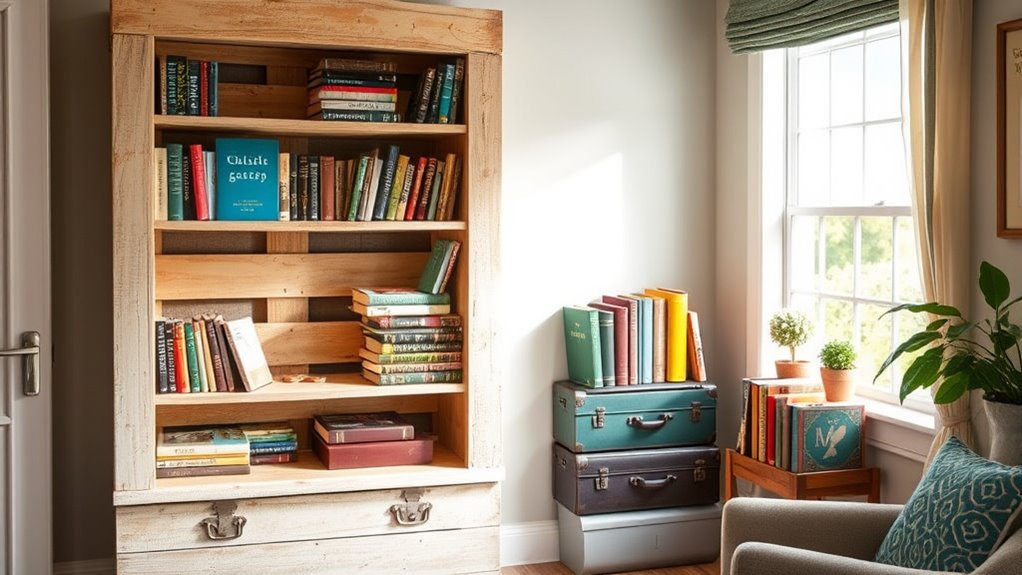
You can save money by repurposing old furniture or materials into unique pieces for your library. Crafting custom shelves from reclaimed wood or crates adds personality and functionality without the high cost. These DIY projects not only personalize your space but also give new life to items you might otherwise discard. Incorporating vintage decor elements can further enhance the rustic charm and authenticity of your farmhouse-inspired library.
Repurpose Old Materials
Repurposing old materials is a cost-effective way to create a personalized home library without spending a fortune. You can get creative by reusing packaging to make unique storage solutions or transforming furniture to better fit your space. For example, sturdy cardboard boxes can become charming bookcases with a fresh coat of paint, or old crates can serve as stylish storage. Reusing packaging not only saves money but adds character to your library. Additionally, refurbishing outdated furniture—like turning an old dresser into a book display—can bring a vintage feel. To enhance your setup, consider selecting the right projector type based on your space and needs, ensuring that your home library is both functional and visually appealing.
Craft Custom Shelves
Have you considered crafting your own shelves to add a personal touch to your home library? DIY shelves can be both functional and stylish, especially when you incorporate upcycled materials. Use simple bookbinding techniques to reinforce old wooden crates or vintage suitcases, turning them into unique storage units. For lighting, explore shelf lighting options like LED strips or clip-on lamps to highlight your collection. Here’s a quick idea table:
| Material | Design Ideas | Lighting Options |
|---|---|---|
| Reclaimed wood | Floating shelves, ladder shelves | LED strip lighting |
| Vintage suitcases | Hidden compartments, display cases | Small clip lamps |
| Pallets | Wall-mounted, tiered shelves | Under-shelf LEDs |
Additionally, understanding the science behind sound vibrations can inspire creative lighting or decoration ideas that enhance your library’s ambiance. Get creative, and your shelves will be both budget-friendly and genuinely yours!
Organize and Display for Maximum Impact
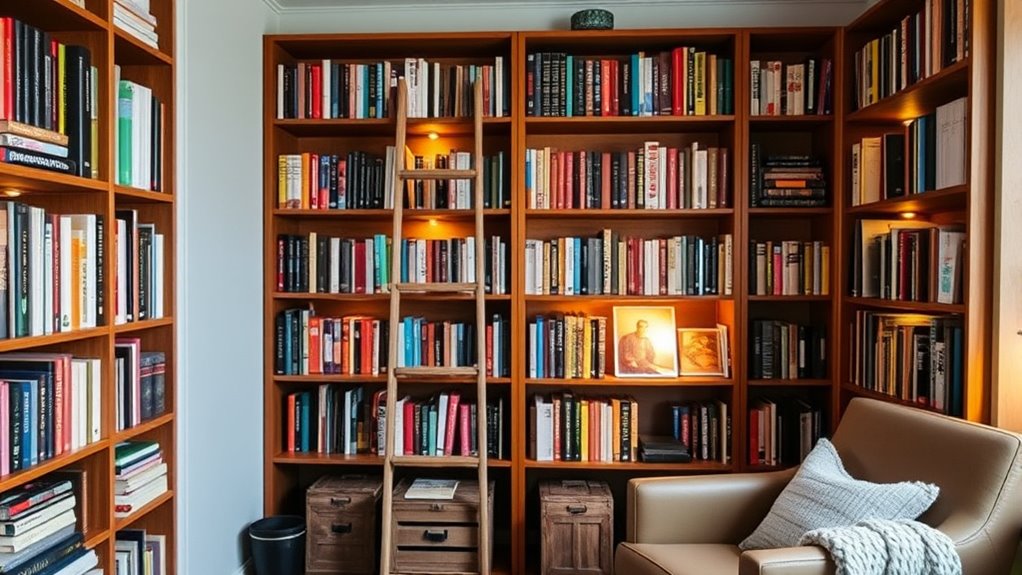
To create a striking and functional home library, thoughtful organization and strategic display are essential. Proper book arrangement enhances visual appeal and makes retrieval easier. Consider grouping books by genre, color, or size to create visual impact through decorative displays. Mixing books with decorative objects like plants or art pieces adds personality and style. Use varying shelf heights to showcase special editions or favorites prominently. Keep frequently used books within easy reach and rotate displays seasonally to keep the space fresh. Incorporate labels or signage for a library-like feel. These strategies help balance aesthetics and practicality, transforming your collection into an eye-catching, inviting space. Additionally, employing vertical storage solutions can maximize space and keep your collection organized and accessible.
Maintain and Grow Your Library on a Budget
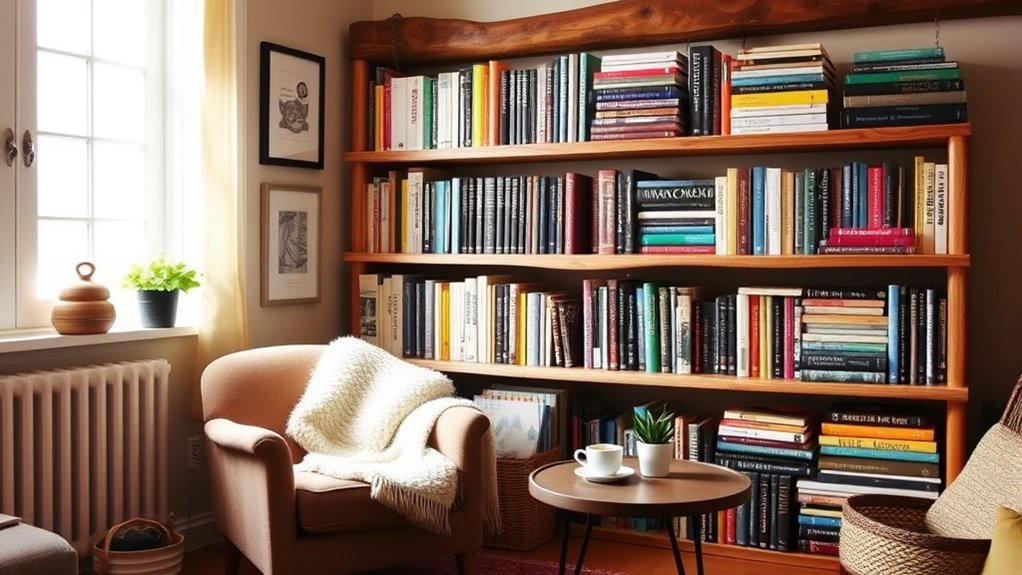
You can keep your library growing without breaking the bank by exploring thrift stores for hidden gems or swapping books with friends. These options let you access a wide range of titles at little to no cost. With a little effort, you’ll expand your collection while staying within your budget. Additionally, optimizing your book collection by categorizing and labeling titles can make browsing easier and more enjoyable.
Thrift Store Book Finds
Ever wondered how to expand your library without breaking the bank? Thrift stores are treasure troves for budget-friendly book finds. You can discover vintage covers that add character to your shelves or stumble upon rare editions worth collecting. These stores often have a diverse selection, making it easy to find books aligned with your interests. To maximize your haul, look for well-preserved copies, first editions, and unique cover art. Keep an eye out for books with historical significance or signed copies. Visiting regularly increases your chances of uncovering hidden gems. Thrift store book hunting not only saves money but also makes building a personal collection exciting and sustainable. Additionally, paying attention to book condition can ensure your finds are in good shape and retain their value.
Swapping With Friends
Building a personal library doesn’t have to rely solely on purchasing new or thrifted books; sharing and swapping with friends offers a cost-effective way to expand your collection. Book swapping allows you to exchange titles with friends, giving everyone access to new reads without spending extra money. This process not only saves you money but also strengthens your friendships through shared interests and regular contact. Plus, swapping books keeps your collection fresh and diverse, exposing you to genres and authors you might not have explored otherwise. It’s a simple yet effective strategy for maintaining and growing your library on a budget. By making swapping a routine, you create a community of readers who support each other’s love for books while keeping costs low. Engaging in book exchanges can also introduce you to new authors and genres, enriching your reading experience even further.
Frequently Asked Questions
How Can I Protect My Books From Humidity and Pests?
To protect your books from humidity and pests, you should use book humidifiers to maintain a stable environment and prevent mold growth. Keep your books in a cool, dry place away from direct sunlight. Use pest deterrents like cedar blocks or lavender sachets to ward off insects. Regularly inspect your collection for signs of pests or moisture, and handle your books carefully to keep them in great condition.
What Are Some Online Resources for Free or Discounted Books?
You can explore digital libraries like Project Gutenberg or Open Library for free books, perfect for building your collection without spending. Additionally, keep an eye out for ebook discounts on sites like BookBub or Amazon, where you can find affordable or free titles. These resources make it easy to access a wide range of books online, helping you grow your library on a budget while enjoying diverse genres and authors.
How Do I Prioritize Books When Space Is Very Limited?
When space is limited, you need smart book organization and space optimization. Prioritize books that bring you the most joy or serve a specific purpose, like reference materials. Use vertical storage and multi-functional furniture to maximize space. Regularly declutter, donating books you no longer need. Keep your collection manageable by focusing on quality over quantity, ensuring your home library remains functional and inspiring despite the limited space.
Are There Any Legal Considerations for DIY Shelving Projects?
They say, “Better safe than sorry,” which rings true for DIY shelving projects. Before you start, check if building permits are needed in your area, especially for larger or wall-mounted shelves. You should also review safety regulations to verify your design is secure and stable. Ignoring these legal considerations could lead to fines or hazards, so always prioritize compliance and safety for a successful project.
How Can I Create a Cozy Reading Nook Within a Small Budget?
You can create a cozy reading nook on a small budget by using DIY decor ideas like repurposing old furniture or adding soft cushions. Incorporate warm lighting ideas such as string lights or battery-operated lamps to make the space inviting. Use inexpensive fabrics for curtains or throws, and personalize with your favorite books and artwork. This approach keeps costs low while transforming a small corner into a comfortable retreat.
Conclusion
Your home library is a seed you plant today, symbolizing your passion for knowledge and growth. With careful planning and creativity, you nurture this seed into a thriving garden of ideas. Each book added is a blossom, enriching your space and mind without breaking the bank. Keep tending your collection, and watch as your humble library transforms into a sanctuary of inspiration and discovery—proof that with effort, even modest beginnings can bloom beautifully.
